The Regression stories below are taken from one of Alan’s books, “True Ghost Stories” and are a true reflection of real events that took place during his stage demonstrations of Past Life Regression. If you would like further information “True Ghost Stories” may be purchased from Amazon in paperback by clicking this LINK.
Regression one.
On 22nd March, 2011, TV Spirit Medium Derek Acorah and I were performing at the Garrick Playhouse Theatre, near Manchester, when I experienced one of the most amazing emotional regressions that I have ever witnessed. We were performing to a full house, the audience all eagerly waiting and ready to participate. Shortly after we had made our joint stage entrances and been introduced, Derek retired from the stage and I commenced my induction. Nothing could have prepared me for what we were about to tap into.
The Garrick Playhouse Theatre.
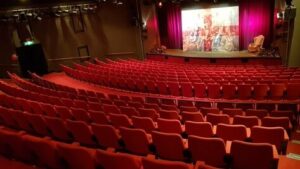
I had twenty willing participants on stage and nine of them were successfully regressed into past lives, all living in long forgotten times – and then I made contact in a past life with a lady named Joyce Ashton.
Joyce was deeply regressed to the Second World War and was living in Dewsbury, a small town near Leeds, with her husband, Thomas, and their young son, Robert. Thomas Ashton was a British soldier, an engineer, and held the rank of private. Thomas was killed in enemy action in Belgium on 2nd October, 1941, but his body was never recovered.
Meanwhile, Joyce was raising Robert singlehandedly, contributing to the war effort by making tank shells in a munitions factory, named Steeton’s. Steeton’s, it seems, was a really big factory and people were bussed in from a 20 miles radius to work there. Lots of day to day information was recorded about her life in general, including St. Johns School and Anglican Church, which her son Robert attended. The feeling that I was receiving from Joyce was one of deep sadness, due to the loss of her husband. By now, the entire theatre audience were sitting on the end of their seats, listening in complete silence, and you could have cut the atmosphere with a knife.
I then progressed with the timeline of this regression incarnation to Joyce’s eventual passing. I guided her to the last moments of that life, and she relived it for us, sharp with tears and sadness. Joyce gave an accurate account of how she worked and how to pack down the explosive charge on a press. There was an accident – a shell exploded and killed four people, including Joyce.
Joyce was working on the press with three other women when a spark ignited the gunpowder and blew the press to pieces, killing all of the women. When I asked what her last thoughts were, she replied with tears rolling down her cheeks: “Who is going to look after my child now?” The audience gasped with emotion, such was the atmosphere in the theatre. After the regression had ended, I brought Joyce forward to the present time, and by now she was fully aware that some powerful emotion had moved her deeply due to the fact that her eye mascara and makeup, mixed with her tears, had run into her lap.
The regression subject was a lady named Gillian Perry, from Manchester. Gillian is a calm, intelligent and down-to-earth person, who has never been to Dewsbury and was unaware of the entire event.
Postscript.
Research was conducted into the information that we had received during the regression and it transpired that Steeton’s ammunition factory did exist, but sadly all that is left now is just a small square red brick building, named the pill box, (image below) and, surprisingly, it is a “listed building”. We could not find any records for this particular accident, but a lot of accidents were hushed up for morale and propaganda purposes and, at most, received an inch or two in the local paper, with no mention of exactly where the people died, other than “a factory”.
In 2010, English Heritage listed the single-storey pillbox. It was built as a defence for the village’s Royal Ordnance Factory and manned by a factory-based Home Guard unit.
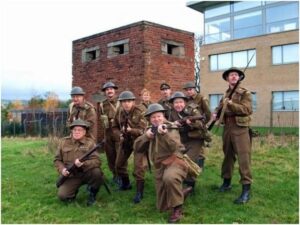
St. Johns School and Anglican Church, which her son Robert attended, exists in Dewsbury. There are registered births and deaths for Joyce and her husband, a birth entry for her son, but not a death certificate. Could you imagine the consequences if a search for her son was successful and what it would be like to re-unite them today?
There is the possibility that he may still be alive. Maybe he was evacuated to Australia or Canada and adopted after the war – a lot of maybes, I know – but maybe his mother still needs to know he has had a good life. We may never know, but one thing is sure, Gillian had an amazing past life regression and a life deepening experience.
The jewel in the crown in our research was the discovery of T. W. Ashton on the war memorial in Crow’s Nest Park, Dewsbury.
![]()
Regression two.
On 7th September, 2006, I was presenting a show in Lancashire. One could feel the atmosphere upon entering the auditorium and I was very keen to start the performance.
As usual I had twenty volunteers on stage and I was happy with my delivery and presentation, and, of course, the quality of the regressions, being most important. Halfway through the show, I regressed a middle-aged, well-spoken lady into a very deep trance state, and while communicating with her in a past life, it transpired she lived in London, and her name was Mary Kelly. The year was circa 1888 and her regressed incarnation was a working prostitute. All aspects of her private and working life unfolded on my stage, including Mary providing sexual services to seamen, and when I mentioned different nationalities, including the French, she remarked that she had worked a brothel in Paris. Mary also added that she had an illegitimate child. She said that times were very hard and she was leading a very sad life.
As the dialogue continued, and the information continued to flow, I guided her to the final part of her incarnation, and she started to tell me that she was brutally murdered. At this point, a man in the audience stood up and shouted loudly, “Mary Kelly was the last prostitute to be murdered by Jack the Ripper!” I did not know this, but now the audience were buzzing with excitement.
At the end of the session, once the regression subjects were returned to “local time”, I proceeded to interview this lady, live on stage. She had no memory of what had happened, to where she had travelled, nor to who she once had been. I was teasing her over the microphone, to the delight of the audience, when I said, “Would you like to know what work you did in London in 1888? This rather reserved lady was curious as to why the whole audience and I were focusing on this particular point. She said, “Yes. Please tell me.” And, after a little more teasing and milking her curiosity, I said, “You were a prostitute. And, it gets worse – you were murdered by Jack the Ripper!” The expression on her face was priceless. You could see she was genuinely taken aback, speechless. I used my charm and cheeky demeanour to best effect and reassured her that this was in the past and bore no reference on her present life.
I must warn you now that the information below is of an extremely gruesome nature and may upset you. There are so many theories as to who was Jack the Ripper? Due to the passage of time and even with modern science I believe his true identity will never be known.
Facts we know about Mary Kelly, and a detailed description of the body upon discovery.
Mary said she had first come to London in 1884 and had begun working as a prostitute in a brothel in the West End. One of her clients had taken her to France, after which she began to call herself Marie Jeanette Kelly. After returning to London she took up with a man named Morganstone, who lived in Stepney. After that relationship ended she began living with Joe Fleming in Bethnal Green Road. In due course, she moved to the East End, living first with a Mrs. Buki and later at Mrs. Carthy’s at Breezer’s Hill, Pennington Street.
Little of this story can be demonstrated to be hard fact, and Mary may have invented much of it to give herself a more glamorous past. However, writer Bob Hinton has done some excellent research into Mary Kelly’s history and for the reader that would like to research this mystery his books are available for purchase.
Mary Ann Cox, another prostitute lived at Miller’s Court, the same location as Mary and had known her for about nine months. Mary Ann had been out soliciting in Commercial Street and returned to her room to warm herself about 11:45 P.M. on the 8th, November 1888. As she turned into Dorset Street she saw Mary Kelly walking in front of her, in company with a man. At the time Mary Kelly seemed to be much the worse for drink, and Mary Ann watched, as the couple turned into Miller’s Court.
At midnight Mary Ann went back out, returning to Miller’s Court again at 1 A.M., at which time she heard Mary singing inside her room. When Mary Ann returned for the last time at 3 A.M., there was no light from the windows, and all was quiet. Throughout the rest of the night, she slept fitfully. She heard several men entering and leaving the court and finally heard someone leave at 5:45 A.M., though she could not say from which room.
The next day a Mr McCarthy who owned the property, and upon his financial accounting discovered that Mary had run up rent arrears to the tune of 29 shillings. So, McCarthy sent his assistant Thomas Bowyer to call on Mary and see whether he could get some money from her. Bowyer could not get a response from Mary’s room and so he looked through the window and saw what looked like two piles of flesh on a table. Then, as his eyes grew accustomed to the darkness inside the room, he also saw a body lying on the bed and a great deal of blood. Bowyer turned and ran back to his employer’s shop, where he gasped, “Governor, I knocked at the door and could not make anyone answer, I looked through the window and saw a lot of blood.”
The police were called and when they eventually entered the room they discovered a most heinous mutilation and murder. The description I present below is from the official Scotland Yard police report.
The body was lying naked in the middle of the bed, the shoulders flat, but the axis of the body inclined to the left side of the bed. The head was turned on the left cheek. The left arm was close to the body with the forearm flexed at a right angle and lying across the abdomen. The right arm was slightly abducted from the body and rested on the mattress, the elbow bent and the forearm supine with the fingers clenched. The legs were wide apart, the left thigh at right angles to the trunk and the right forming an obtuse angle with the pubes.
The actual image below of murdered prostitute Mary Kelly in 1888.
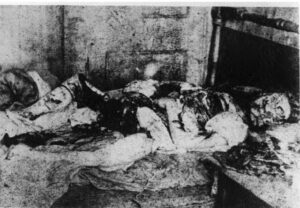
The whole of the surface of the abdomen and thighs was removed and the abdominal cavity emptied of its viscera. The breasts were cut off, the arms mutilated by several jagged wounds and the face hacked beyond recognition of the features and the tissues of the neck were severed all round down to the bone. The viscera were found in various parts, the uterus and kidneys with one breast under the head, the other breast by the right foot, the liver between the feet, the intestines by the right side and the spleen by the left side of the body. The flaps removed from the abdomen and thighs were on a table.
The bed clothing at the right corner was saturated with blood and on the floor beneath was a pool of blood covering about two feet square. The wall by the right side of the bed and in a line with the neck was marked by blood which had struck it in a number of separate splashes. The face was gashed in all directions, the nose, cheeks, eyebrows and ears being partly removed. The lips were blanched and cut by several incisions running obliquely down to the chin. There were also numerous cuts extending irregularly across all the features. The neck was cut through the skin and other tissues right down to the vertebra, the fifth and sixth being deeply notched. The skin cuts in the front of the neck showed distinct ecchymosis. The air passage was cut at the lower part of the larynx through the cricoid cartilage.
Both breasts were removed by more or less circular incisions, the muscles down to the ribs being attached to the breasts. The intercostal between the fourth, fifth and sixth ribs were cut and the contents of the thorax visible through the openings. The skin and tissues of the abdomen from the costal arch to the pubes were removed in three large flaps. The right thigh was denuded in front to the bone, the flap of skin including the external organs of generation and part of the right buttock. The left thigh was stripped of skin, fascia and muscles as far as the knee. The left calf showed a long gash through the skin and tissues to the deep muscles and reaching from the knee to five inches above the ankle.
Both arms and forearms had extensive and jagged wounds. The right thumb showed a small superficial incision about one inch long, with extravasation of blood in the skin and there were several abrasions on the back of the hand and forearm showing the same condition. On opening the thorax, it was found that the right lung was minimally adherent by old firm adhesions. The lower part of the lung was broken and torn away. The left lung was intact; it was adherent at the apex and there were a few adhesions over the side. In the substances of the lung were several nodules of consolidation.
The pericardium was open below and the heart absent.
Postscript.
After the show, I was so excited to get home to research for information on Mary Kelly but at this point I was not privy to the gruesome manner of mutilation that I have provided above. I was thrilled to bits as everything she said during the regression was very accurate. She also gave additional information that is not in the public domain. Looking back, I believe I sadly missed the opportunity to ask her the most important question – the identity of Jack the Ripper. If I had done so, we may have had the identity and the answer to an age-old mystery (or another conspiracy theory). I had no contact information for the lady so sadly I had no way to get back in touch.
Regression three.
In 2008, The Paranormal Experience tour was booked into the Gladstone theatre, near my former home in Port Sunlight village, Wirral.
Derek and I had performed at the theatre there in the past. But, on this occasion, one particular regression case stood out from the rest and is worthy of inclusion in this chapter. This regression was so filled with emotion and with such a great amount of clear detail that, after the demonstration, Derek and I decided to research and film the results.
It was here that I met Mr Boyd, a care worker from Wallasey. I regressed him back through the passage of time to 11th November, 1735, in the city of Gloucester, England. His name in this past life was Jack Mahon. Jack was 18 years of age, and from first contact, he spoke with a completely different dialect, in keeping with folk from that part of England, yet very different from his usual voice. Jack worked for a company named H. & Sons, (see picture) and lived in a house on Skinner Street in the city. There were no numbers on the houses there and his house was described only by the colour of its door. Derek interacted well with Jack throughout the regression and the following further information was received.
The house on Skinner Street.
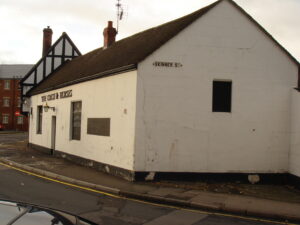
Jack had taken a fancy to a young lady named Mary Jane Smith and, at the age of twenty, they married and had one son, John, named after his grandfather. At the age of four, John had had a walking difficulty which was never rectified. They were a religious family and attended the local Church of England church. Jack had no official schooling but received some education as a child at the church and from two people he called Father James and Sister Anne.
Throughout the regression, Jack’s playful character became very obvious. Sister Anne did not like frogs and during one Sunday service he placed a frog onto the pew next to her. The result was exactly what Jack had anticipated – screams and uproar. At certain times, for reasons we didn’t discover in the dialogue, Jack was punished by birching – sometimes known as whipping or flogging. This punishment was widely used at that period in history, and it was still being used in the Isle of Man up until January 1976, when I was a child. People on the mainland kept writing to the media about how effective it was to thrash kids with “the birch” and asking for it to be brought back!
Information regarding his work at H. & Sons revealed discrepancies with their accounts, and Jack’s position within the company was what would be described today as a stock taker. Jack had discovered that commodities on the docks were not tallying with inventories and this led, as it usually does, to conflict with the workers he was associated with. Overall, I believe that Jack lived a happy life.
H & Sons circa 1850.

Towards the end of the regression, I instructed him to travel within the timeline of this incarnation to his eventual passing. In his last few moments, his breathing slowed and his body calmed dramatically. During the whole regression, his hands had been shaking, but now, in these final moments, his body began to settle, and he became very peaceful. Jack died at home while his wife Mary tended to him.
Derek, who was very intensely focussed on the situation, picked up a strange fragrance – possibly of an old form of disinfectant that may have been used – and then, just at the moment of passing, he also picked up the presence of an old lady, possibly his mother in spirit form.
Jack’s body was buried in his local churchyard.
Postscript.
We were in possession of so much material that a decision was made to investigate further, and so arrangements were made with Square One Pictures, under the guidance of producer Roger DaSilva and the watchful eyes of New York film director, Chase Johnston Lynch, to travel to the city of Gloucester with the subject, Mike Boyd. Some research was conducted before our travel and we discovered that the church, Skinner Street and H. & Sons had existed in the year 1735, and the business continued to trade. The picture shows H. & Sons circa 1850. It was all getting very interesting.
As we entered Skinner Street on foot, Mike became rather emotional. Our research concluded that Jack’s home had been demolished, but he did not know this at the time and had a déjà vu feeling when he stood in Skinner Street, pointing out where his house once stood. This proved correct, too, according to the plans at the local archives.
Mr Boyd experienced a sensation of being drawn to the old abbey. Here, he pointed out that all the graves had been removed in 1800. This gave him feelings of a past soul progression to the present day, linking his past life to the present one. This raises the question: “Do those souls from our past lives also link in with our present soul?” Efforts to find the grave were dashed when we discovered a lot of the graves were lost and buildings had been developed on the former burial grounds.
This was really satisfying to me. In my view, this is what past life regression is all about, not just vague and boring, the name of a country, and the name of a husband or wife. This is the meat on the bones, verifying against all odds the proof of the spirit or soul progressing by whatever the means from generation to generation.
Regression four.
This is my final story of regression, so join me as we visit Liverpool, a world-famous city, and rightly so, with its diverse cultures, its friendly inhabitants, great history, and, of course, The Beatles.
The date is 18th April, 2012, and I was invited by a friend to give a private regression to one of her friends, who I will name Edward. Edward is a serving police officer in North Wales but he resides on the Wirral, just a few miles west of Liverpool, and commutes across the English – Welsh border, to and from his work. I had not met Edward before but he struck me as a nice gentleman, well mannered, of sound mind, and very professional.
Edward entered into a trance state very quickly and his communication was very clear and audible. He rapidly regressed back to a lifetime that was lived near the dockland in Liverpool, in the year 1902. His incarnate name here was John Pritchard. He gave his address as 5 Cuthbert Street, Liverpool, and he was aged 27 at the point of contact. John was married to Brenda, two years his junior, and he described himself as an abusive and violent alcoholic.
During his early childhood, he attended the school of St. Mary’s, and although a Catholic, did not go to church or follow his religion. Money was very scarce and, looking back, the working classes had it so very much harder in those days, in comparison to what we have experienced in current times. His parents were John and Margaret. Even as a young child, he was very unhappy. There were no children born from this marriage to Brenda and, as time progressed, he became more violent and abusive to his wife. It was not a happy existence; from childhood to old age, the poverty was crippling.
John was a docker, or stevedore, and his job was to unload wool from the ships into boxes. Now, during the regression, I had noticed he was continually rubbing and scratching his arms. He explained that the wool constantly itched his arms and that his arms and hands were always red raw.
How it would have looked for John Pritchard in a past life at work on Liverpool docks circa 1912.
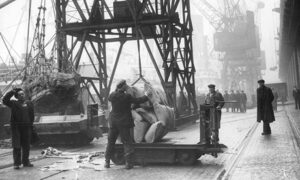
Then, towards the end of the regression, I guided him on a time line to the last hour of this existence. He described the scene up to his last breath, aged 68, a doctor and his wife present to hear his last words as he lay in bed at his home. His liver was shot with the ravages of alcoholism, and he felt that Brenda would surely be relieved that he had gone.
I had one more final question: “Where is your body buried?” He replied, “In a churchyard in South Allerton, Liverpool, and the headstone is near to a tree.”
Postscript.
I left Edward after the session, but not before we chatted briefly on what I had experienced during the regression. He remembered nothing at all and was a little taken aback when I recapped on his past life.
I recorded the whole regression for Edward to take home with him. Since then, he has conducted his own research into the life of “John Pritchard” and has confirmed that virtually the whole regression was verifiable. However, the one thing that he cannot find is the final resting place – his grave.
Edward is a very proud Welshman, but he told me something very interesting. “Every time I travel into the city of Liverpool, I have a strange feeling of coming home.”
